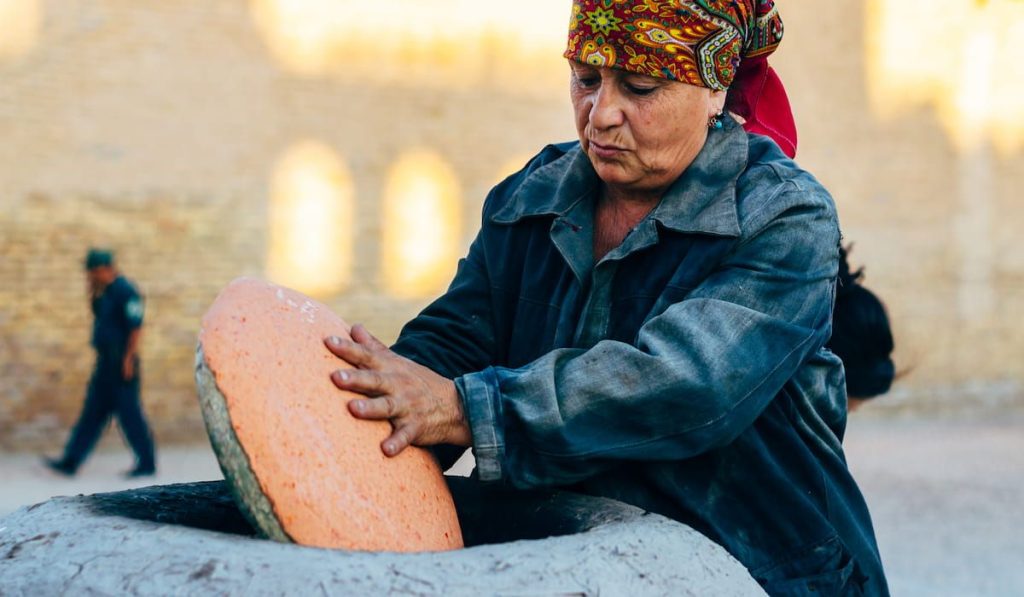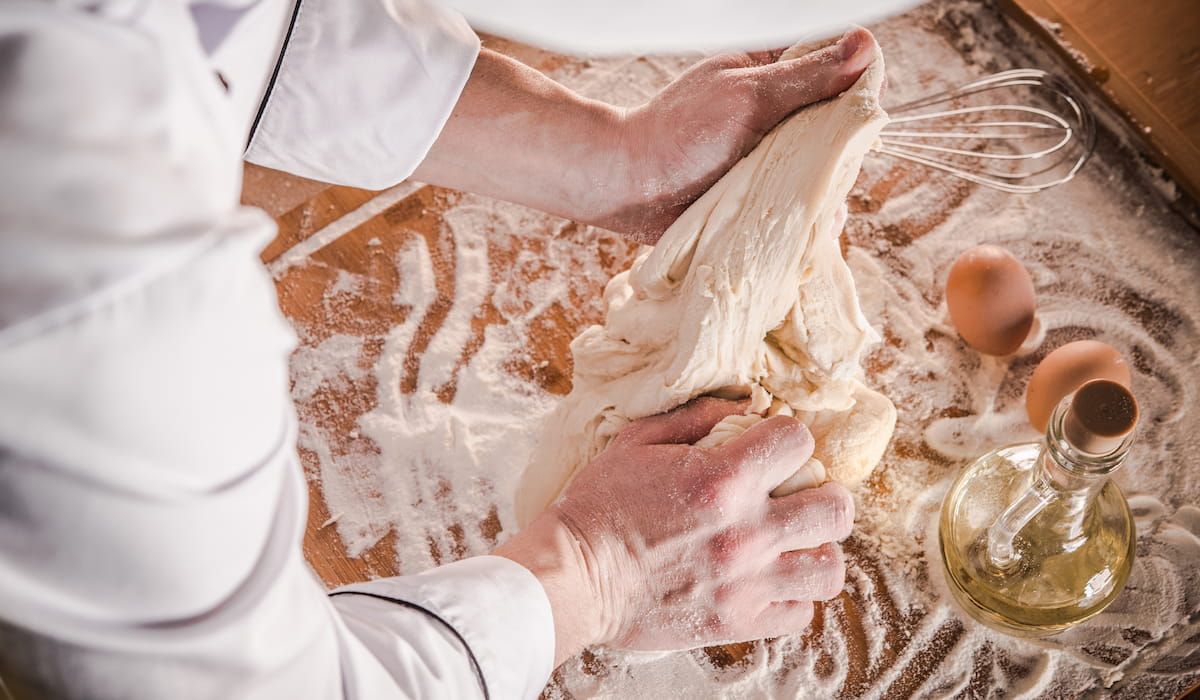Are you considering taking up a hobby? Perhaps something that can occupy your mind and help you to relax? Then breadmaking may be exactly what you’re looking for.
This is a hobby that you can really sink your teeth into, and it’s ideal for a beginner.
Additionally, this versatile hobby can be adapted to fit any unique dietary requirements you may have (like a strictly gluten-free diet, vegan diet, etc).
Breadmaking is a Simple Way to Relax
When you’re looking for a hobby, if you’re like most of us, you’re probably not looking for more busywork. Rather, a hobby should serve as a valuable addition to your life, bring fulfillment, and of course, help you to relax!
A hobby should serve as a break from the daily rigors and enable you to let your creative juices flow.
As far as hobbies go, breadmaking is quite popular. It combines age-old techniques and modern innovation, and just a little common sense and know-how. It is nice and simple, and the results – a fresh-baked loaf of bread – never disappoint, once you’ve got the knack.
So, if you’re looking for a hobby that is artistic, welcoming to beginners, and practical (and delicious), look no further. Breadmaking may be your answer.
Breadmaking Honors Ancient Tradition
Breadmaking is not just a fun hobby, it’s also an ancient tradition. Records of people making bread have been around since as early as 1000 BC, in ancient Egypt.
First, they used the old dough to ‘leaven’ a fresh dough mix. They would let this sit a couple of hours and then bake. Some also speculate that ancient Egyptians eventually learned to use semi-domesticated yeast, at around 2000 BC.
As a matter of fact, the Egyptians would pay wages in bread, bury bread in tombs and paint bread on the walls, presumably to symbolize nourishment and prosperity, with the latter.
The oldest bread ever discovered is approximately 4000 years old, discovered in the ancient mortuary temple (AKA tomb) of Mentuhotep II.
Bread was valued as such a necessity that those passing on wished to bring it with them to the afterlife, along with treasure, servants, etc.

Breadmaking is Super Versatile
Breadmaking is great because it is so versatile. You can choose your difficulty, and pick recipes that are nice and basic, or more complex.
For example, it takes just a few hours to throw together a honey wheat loaf. Sourdough bread, on the other hand, will require an aged starter. The starter will need to ferment for about a week.
How long your bread takes and its difficulty, will also depend on the quality you are going for. Many are content with a nice, old-fashioned bread loaf. If you want to go out of your way to impress, you can try more in-depth recipes, and pay special attention to the texture, the holes on the inside, etc.
To learn more about what to look for in a top-quality loaf of bread, read below.
Good for Both Body and Soul
Bread is a food staple all around the world, from the crusty baguettes of France to the dense flatbread of Africa, to the fluffy fry bread of the northern US.
There’s a reason bread is so sought-after. First and foremost, it’s highly sustaining and provides excellent nourishment. It’s also delicious and seems to be perfect comfort food for more folk.
You can make types of bread that are beneficial for your health or indulge in a buttery white bread loaf. Bread (and breadmaking) is good for both the body and the soul.
Why is Breadmaking Considered Such a Wonderful Hobby?
1) Anyone Can Do It
Who can bake? Anyone. This is a wonderful hobby for those in full health, or those who are disabled, or experience chronic fatigue, etc. Baking does not discriminate (as few things should!).
If you have allergies to wheat, no problem. Today, there are so many gluten-free recipes to choose from; not to mention dairy and egg-free (vegan). You can also alter just about any bread recipe to suit your needs, once you know how.
Even kids can try their hand at bread making – with 100% adult supervision. Your child should be old enough to understand what they’re doing completely, and any risk (heat, etc.).
2) Breadmaking is Very Affordable
Is bread-making expensive? Not at all. The ingredients are so simple: yeast, water, flour, oil. Some go as far as to request eggs, honey (a tad pricier but nearly always optional), or milk. None of these ingredients are expensive, however!
In fact, making your own bread can be quite cost-effective. The bread will be much higher quality than store-bought, for a fraction of the price.
Imagine how much bread you can make with just one good-sized bag of flour. Even if you’re making bread often, a bag of yeast can last you up to nearly half a year.
3) Do You Need to Take Lessons in Order to Make Bread?
You can make bread yourself at home – and, thanks to modern technology, it couldn’t be simpler. It is possible to find almost any recipe on the internet – even ones that are dietarily specific, or with recipes that are traditional and older.
You can perfect your bread-making skill with lessons if you’d like to, however. Just make sure it is affordable, and that you enjoy yourself.
Bread making classes can be found at your local college, or sometimes at a community center. There are also countless bread-making lessons and tips that you can find online, free!
This expertise (and formal lessons) can potentially make it possible to become a professional chef. All you need are the basics, and a little time and practice, and – much like the perfect recipe – it will all come together.
4) Is Breadmaking Done Inside or Outside?
Do you prefer to be outdoors? Never fear. Breadmaking can be accomplished inside or outside. To make bread outside, you will need a dutch oven and a campfire, or a fire-roasting oven of your own. You will also require a table to knead the dough and generally work on.
In truth, cooking indoors is much simpler. This is because you have ready access to refrigerated ingredients, a temperature-controlled oven, a stove-top, a sink, etc.
5) Is Breadmaking Done Alone, in a Group, or With Family?
Is breadmaking best done on your own, or with other people? Well, are you a social butterfly? Or do you cherish quiet time by yourself? In which environment will you find yourself happier? There’s your answer.
You can bake a few loaves with friends, with your spouse (this can actually be quite romantic), or on your own, in the wee hours of the night, after work.
Do whatever makes you feel best; the mark of a good hobby is that it will make you feel better. This is something you’ll want to remember.

How to Tell a Quality Bread Loaf
- A glossy interior You probably knew that a crispy crust was a sign of a good loaf. Did you know that a glossy interior is, too? Not only should the inside of a quality loaf be moist, but the very fibers should also be glossy, as well. This is one sign of a perfectly baked loaf.
- A springy interior. This goes along with the glossy interior. A quality loaf of bread should also have a springy interior, i.e. one that, when you push on it, bounces back. This implies a smooth, even texture, a successful rise, etc.
- A crispy crust. Ah, crispy crust – the second-most-immediate way to tell the quality of a bread loaf. A well-made loaf of bread will have a distinctive crunch, and the crust will crack.
- The presence of air pockets. Some say that you can tell a bread is good simply by looking at the air pockets inside the loaf. These indicate that the bread has risen well – when the bubbles are many, and large, it means that it has risen exceptionally well. This is one feature you will eventually want your own, homemade bread to have (and something every breadmaking enthusiast gradually works up to).
- A noticeable and pleasing smell and flavor. Some bread is just insubstantial, isn’t it? A bit like eating fluff. A loaf of true caliber will smell richly of whatever grain it is made from, as well as well-risen and baked yeast, and maybe a bit of the finish and butter. This should merely be an introduction to the taste but is still a strong indicator in the bread’s favor.
- A finish. Everything’s in the details. Homemade bread just isn’t complete without a shiny finish of egg wash or butter. This will keep the crust from drying out completely, maintaining a toothsome, flexible chew.
Alternative Hobbies Similar to Breadmaking You Might Prefer
Maybe you’re not that big of a fan of bread. Or, perhaps you’d been there, don’t that. You could already be a pro. Are you a dessert kind of guy or gal? Or you might wish to pair your bread making with jam-making, as well.
These are all hobbies that are quite similar. Dessert-making is a tad pricier, but can also be very affordable as you have complete control over your recipes, ingredients, etc.
Is it summer or fall where you live? You can pick some berries to kick-start your jam-making – free! All that you need is heaps of berries, a stovetop, some enthusiasm, and your choice of sweetener.
Breadmaking for Children
You can absolutely make bread with your kids, as well. In fact, baking with your kids can be a great way to bond with them, and teach them how to take care of themselves for when they are finally – no time soon – on their own.
In the meanwhile, bread is simply lots of fun to make. If your kiddo is quite young, maintain control over the situation and allow them to add – carefully measured – flour or oil, etc.
They will soon have fresh-baked bread to enjoy for their “hard work.” Breadmaking with your kids is an opportunity for some fun, and a life lesson, in one. Win-win.
Breadmaking for Adults:
Breadmaking is a hobby you’re sure to find both fun, and useful. Around the holidays, for example, fresh-made bread is a heartwarming – and belly warming – gift.
You can drop it off at the door, bring it with you to family events to share, etc. Not everyone can make a good loaf of bread, and it’s always an appreciated ability to have!
With just a few basic supplies, you can enjoy homemade bread made into breakfast toast, garden-fresh sandwiches, and so on. This will bring a savory comfort to every partly homemade meal.

Popular Breads You Can Learn to Make on Your Own
French
French bread came to be in the 1900s, in France. Up until then, dry ovens were all that were available. Then steam oven was invented, allowing loaves to have a thick exterior and soft interior.
That is the classic French bread. Technically, in order to be classified as a true French bread, a bread must be made up of only yeast, salt, flour, and water.
Rosemary Focaccia
Have you ever heard of focaccia? It is popular at Italian restaurants, bakeries, and more. This flat, oven-baked bread originated in Italy, and has a pleasingly chewy texture throughout, with a semi-crisp and buttery exterior.
The most noteworthy of the focaccia ingredients (your standard water, flour, etc.) is olive oil. This is part of what creates such a dense loaf.
Sourdough
Now, this is a baking accomplishment anyone can be proud of. Sourdough can be a trickier bread to make, but if you know what you’re doing, your efforts will pay off.
Instead of using classic, ready-to-go yeast, sourdough requires that you make your own starter. This can be whipped up pretty quickly, as all it takes is a little flour and water.
The starter will need to be allowed to ferment (“mature”) for about a week. Then, it can be used like a very flavorful yeast, to create a chewy and tangy sourdough of your own.
Rye
Rye bread is a popular option, made either partly or entirely of rye flour rather than wheat flour. Rye has a strong, earthy flavor. It’s slightly sour.
Unlike most bread recipes, many for rye call for molasses or honey, to give it its rich color and flavor.
Pumpernickel is similar, in that you use very little to no wheat flour.
Honey Wheat
Honey wheat: a hearty, heart-friendly, moist, somewhat-sweet leaf. The perfect kind of bread for a peanut butter and jelly sandwich, or some ‘French Toast’ (bread dipped in whipped eggs and milk and cooked on a pan in butter), etc.
Just make sure you have a pot of the honey of your choice nearby – and save some as a freshly baked bread topping for later.
Basic Bread Making Supplies Needed for the Beginner
Rolling pin
If you’re going to be embarking into the world of bread making, then you will almost certainly want a rolling pin.
Plastic rolling pins are generally considered too flimsy, while marble rolling pins are considered ideal. These have a weight that really helps flatten and distribute dough, and they can even be placed in the refrigerator to chill.
Wooden rolling pins are your second-best choice and also perfectly OK.
Cutting Board
To make bread, you will likely want a cutting board, which will spare the surface of your counter. You can use the board when the counter is dirty, in order to knead the dough, or shape it; you can also use it after, as you cut your fresh-baked loaf.
Glass cutting boards are the most resistant to germs, and the easiest to clean, by far.
Flour
If you’re going to be making loaves of bread, you will need a big old, hefty, trusty bag of flour. Or two: one of wheat flour, and one of white flour.
Or do you have a gluten allergy? Then go ahead and toss aside the wheat products for a quality potato, almond, or brown rice flour.
Making your own bread can give you a lot of freedom, as you won’t have to worry about hidden ingredients in store-bought bread – or nasty preservatives, either.
Yeast
Yeast is what defines many types of bread, from wheat to sourdough… even the simple dinner roll. This is a staple of every bread maker. You will want to have a good-sized bag, stored nestled away in your freezer.
Bread Pan and Mixing Bowl
There are special-made pans that will cook your dough into the shape of a loaf. The best appears to be glass and non-stick. Feel free to pick larger pans, or smaller ones, or ones that are a bit whimsical (for example, a heart-shaped loaf).
Your mixing bowl will need to be both wide and tall. Things can get a bit messy when you’re working with so much flour!
Final Thoughts
So, what do you think? Does the breadmaking hobby catch your interest?
It’s a peaceful, thoughtful hobby that rewards you with your own, homemade, fresh-baked bread loaf. What more can you ask?




